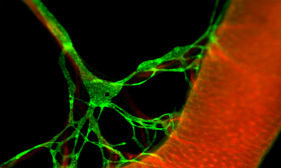Origins of left-sided gut artery, lymphatic system discovered
By Krishna Ramanujan

Researchers have understood very little about how blood and lymphatic vessels form in the mammalian gut – until now.
A new Cornell study reports for the first time how arteries form to supply the looping embryonic gut with blood, and how these arteries guide development of the gut’s lymphatic system.
The study, published online Dec. 4 as the cover story of the journal Developmental Cell, provides a new avenue to explore treatments to prevent cancer metastasis and gut-specific lymphatic diseases. Lymphatic vessels are the main channels for spreading colorectal tumor cells; blood vessel abnormalities are the leading cause of congenital birth defects.
“This is the first study to implicate arteries as the drivers of gut lymphatic development,” said Natasza Kurpios, assistant professor of molecular medicine at the College of Veterinary Medicine and the paper’s senior author. Aparna Mahadevan, a graduate student in Kurpios’ lab, is the paper’s first author.
For the last 100 years, researchers have believed that all lymphatic development depends on veins, not arteries.
The looping of intestines relies on a master-regulator gene, called Pitx2, which controls the counter-clockwise patterning of organ development to fit everything in the body cavity. The study links Pitx2 to the formation of arteries and lymphatics, which only happens on the left side of the developing gut. “But from a biological point of view, asymmetry has to do with plumbing,” said Kurpios.
The gut lymphatic system is necessary to absorb fat and transport it to the liver, where fats are distributed throughout the body. The system also plays roles in educating immune cells to recognize pathogens, and it serves as a conduit for cancer cells to spread through the body.
The study, which examined chicken and mouse intestines, opens the door to investigate new treatments for human diseases. By looking at Pitx2 and related genetic markers and by knowing the mechanism for artery and lymphatic development in the gut, researchers may manipulate the development of the lymphatic system to study many lymphatic-related diseases. Testing the lymphatic system is currently the number one diagnostic method for metastatic cancer, so “if you can block these vessels in the vicinity of cancer, perhaps you can block the spread of cancer,” Kurpios said.
Co-authors included researchers from the University of Southern California. The study was funded by the Cornell Center for Vertebrate Genomics, the National Institutes of Health and the March of Dimes.
Media Contact
Get Cornell news delivered right to your inbox.
Subscribe